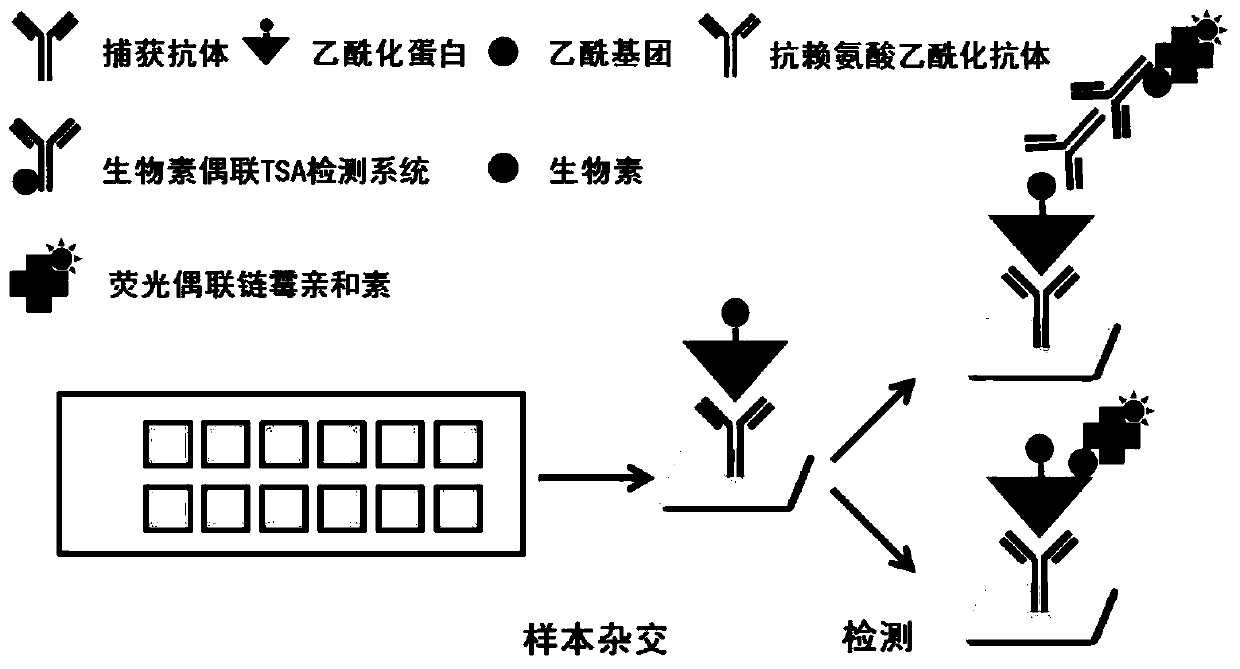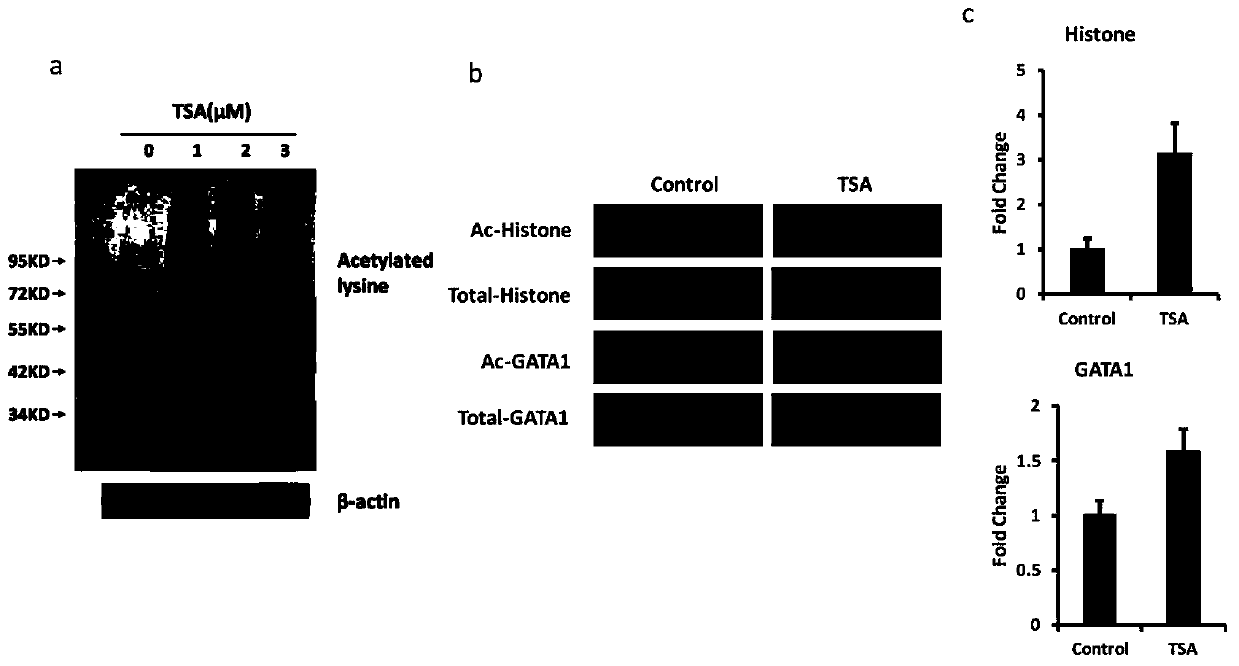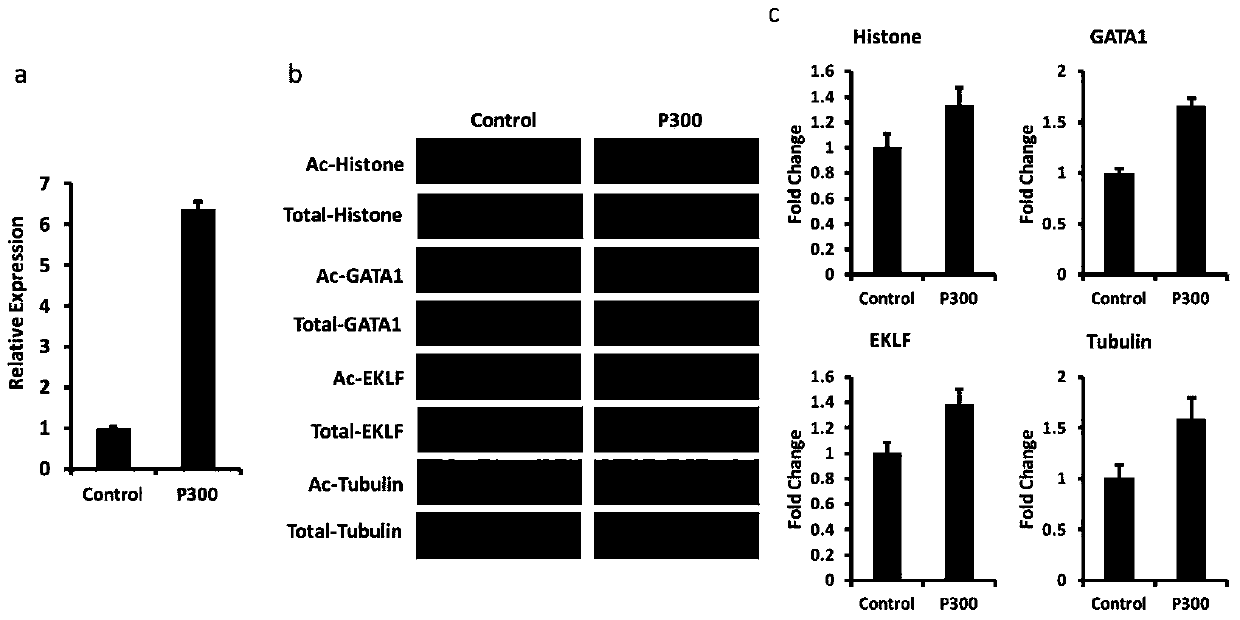Protein chip and kit for detecting protein acetylation level
A protein chip and kit technology, which is used in biological testing, general structural inspection of gas analyzers, measurement devices, etc., can solve the problem of lack of protein chips and kits, and achieve small sample demand and high detection efficiency. , check the overall effect
- Summary
- Abstract
- Description
- Claims
- Application Information
AI Technical Summary
Problems solved by technology
Method used
Image
Examples
Embodiment 1
[0037] The preparation method of the protein chip is as follows:
[0038] The 68 kinds of specific antibodies were diluted to 0.5 μg / μl with PBS-15% glycerol, and the antibodies were spotted onto the chip one by one using the chip spotting platform. The diameter of each spot is 200 μm, and the distance between spots is 500 μm; use biotin-labeled BSA (BSA-biotin) and acetylated BSA (Ac-BSA) as positive controls, and use BSA, mouse IgG, and rabbit normal IgG as negative controls; Put them into a 384-well plate in a certain order, and use a chip spotting instrument to spot the chip. Three replicate spots of ginseng, yin ginseng, and capture antibody are all spotted to prepare a protein chip. The 68 specific antibodies are: AML1, AMPK, APE, AR, α-Tubulin, β-Catenin, Bcl-6, Beclin, BRAF, MYB, c-Myc, CREB, CTBP2, DEK, E2F1, E2F2, E2F3 , EGFR, Her2, Her4, ER, EKLF, FEN1, FOXO1, FOXO3, FOXO4, GATA1, GATA2, GATA3, GATA4, GR, HIF-1α, HMGA1, HMGB1, HSP90, IRF2, IRS1, KRAS, Ku70, MDM2, M...
Embodiment 2
[0041] The detection method of the kit based on the protein chip of embodiment one:
[0042] 1. Sample preparation
[0043] ① Test samples: take 10 6 –5x 10 6 Add 100–200 μl protein lysate to cells or 10–40 mg tissue samples, place at 4°C for 30 minutes and shake from time to time, then centrifuge at 10,000 g for 15 minutes at 4°C, collect the supernatant and quantify it to obtain the test sample ( for detection of acetylation signal);
[0044] ②Background sample: take 100 μg of detection sample, add protein labeling buffer and mix to 50 μl, add 2 μl NHS-biotin and react at room temperature for 2 hours to label, then add 1.6 μl labeling stop buffer and react at room temperature for 30 minutes to stop labeling , and then add 450 μl 1xPBS, put it into an ultrafiltration tube, centrifuge at 10,000 g at 4°C for 30 minutes, and store the ultrafiltrate at -20°C to obtain a blank sample (for detecting protein background signals).
[0045] 2. Protein chip hybridization
[0046] ①...
Embodiment 3
[0053] TSA (Trichostatin A) treated cell model
[0054] 1. Experimental principle
[0055] TSA (Trichostatin A) is a reversible HDAC (histone deacetylase, histone deacetylase) inhibitor, which increases the level of acetylation in cells by inhibiting the process of protein deacetylation. The samples were treated with DMSO and TSA respectively, and the DMSO treatment was used as a control sample. The protein chip and kit of the present invention were used to detect the changes in acetylation levels in cells treated with TSA compared with those treated with DMSO to illustrate the detection effect of the present invention.
[0056] 2. Sample preparation
[0057] Gastric cancer cells MKN45 were cultured in RAPI 1640 medium containing 10% FBS (fetal calf serum, fetal bovine serum) to a density of 70%, and were treated with DMSO and 3 μM TSA for 18 hours to collect cell proteins.
[0058] 3. Test method
[0059] a. Take 10 6 For MKN45 cells treated with DMSO and TSA, add 100 μl ...
PUM
 Login to View More
Login to View More Abstract
Description
Claims
Application Information
 Login to View More
Login to View More - R&D
- Intellectual Property
- Life Sciences
- Materials
- Tech Scout
- Unparalleled Data Quality
- Higher Quality Content
- 60% Fewer Hallucinations
Browse by: Latest US Patents, China's latest patents, Technical Efficacy Thesaurus, Application Domain, Technology Topic, Popular Technical Reports.
© 2025 PatSnap. All rights reserved.Legal|Privacy policy|Modern Slavery Act Transparency Statement|Sitemap|About US| Contact US: help@patsnap.com



